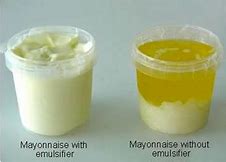How Emulsifier In Food Creates Smoother Recipes
Wiki Article
Why It Is Needed to Include an Emulsifier in Food for Ideal Taste and Top Quality
Emulsifiers play a vital duty in food production by guaranteeing the steady blending of immiscible fluids, such as oil and water. They lower interfacial stress, which avoids the splitting up of active ingredients and contributes to a consistent appearance. This not just improves mouthfeel however also affects flavor perception. Comprehending the necessity of emulsifiers reveals much deeper understandings into their feature and significance in culinary applications. What effects does this have for food innovation and customer preferences?Comprehending Emulsifiers: The Basics
Emulsifiers play a vital role in food scientific research, functioning as representatives that help with the mixing of two immiscible liquids, such as oil and water. These compounds possess both hydrophilic (water-attracting) and hydrophobic (water-repelling) buildings, which enable them to stabilize emulsions. Common emulsifiers consist of lecithin, found in egg yolks and soybeans, and mono- and diglycerides, obtained from fats.The Science Behind Emulsification
When 2 immiscible fluids are integrated, the process of emulsification becomes essential for attaining a steady combination. Emulsification entails spreading one liquid within one more, usually oil in water or the other way around. This procedure takes place through mechanical anxiety, which breaks the larger droplets into smaller ones, therefore boosting the surface. Nonetheless, without the presence of emulsifiers, these beads would certainly coalesce, causing separation.Emulsifiers are molecules with hydrophilic (water-attracting) and hydrophobic (water-repelling) properties. Their distinct framework permits them to minimize the interfacial tension between the 2 immiscible fluids, maintaining the solution. This stabilization prevents separation and boosts the harmony of structure and flavor. The interactions at the molecular level are essential for maintaining the stability of the emulsion, guaranteeing that food maintain their preferred consistency and taste. Understanding this scientific research is substantial for food researchers and makers in creating high-quality food items.
Sorts Of Emulsifiers Made Use Of in Food
The sorts of emulsifiers used in food can be generally categorized right into synthetic and all-natural varieties. Typical food emulsifiers, such as lecithin and mono- and diglycerides, play an essential duty in boosting food security and structure. Understanding these differences is necessary for valuing how emulsifiers add to the general top quality of foodstuff.Synthetic vs. all-natural Emulsifiers
While both synthetic and natural emulsifiers serve the vital duty of maintaining combinations in food items, their beginnings and qualities differ considerably. All-natural emulsifiers, stemmed from plant or animal resources, consist of lecithin, casein, and particular periodontals. They are commonly perceived as much healthier alternatives, attracting customers seeking clean-label items. On the other hand, synthetic emulsifiers, such as mono- and diglycerides, are chemically engineered and may supply enhanced stability and capability in a bigger series of applications. These artificial options can be extra affordable and offer regular quality. They might evoke apprehension among health-conscious consumers. Ultimately, the choice between synthetic and natural emulsifiers relies on the preferred high qualities of the foodstuff, including texture, flavor, and shelf-life stability.Usual Food Emulsifiers
Emulsifiers play an important duty in the food industry, guaranteeing the security and appearance of numerous products. Common food emulsifiers consist of lecithin, mono- and diglycerides, and polysorbates. Emulsifier In Food. Lecithin, originated from resources like soybeans and egg yolks, is widely utilized in baked goods and chocolates. Mono- and diglycerides, commonly obtained from vegetable oils, boost the creaminess of margarine and gelato. Polysorbates, artificial emulsifiers, are frequently located in salad dressings and sauces, promoting a smooth consistency. Various other emulsifiers such as xanthan gum and guar gum tissue, both natural thickeners, likewise add to the wanted appearance in various food products. Each emulsifier type offers particular purposes, adding to the total quality and allure of food products
Duty in Food Security
Food stability is considerably influenced by the kinds of emulsifiers made use of, which aid protect against the splitting up of components in different formulations. Emulsifiers such as lecithin, mono- and diglycerides, and polysorbates play important functions in maintaining the harmony of products like dressings, sauces, and gelato. Lecithin, originated from soy or egg yolk, is specifically effective as a result of its all-natural properties, while mono- and diglycerides enhance texture and rack life. Polysorbates, on the various other hand, improve the security of oil-in-water solutions, making them ideal for baked items. The option of emulsifier relies on the specific food application and preferred features, guaranteeing that products continue to be secure, enticing, and of premium quality throughout their intended service life.Exactly How Emulsifiers Improve Structure and Mouthfeel
Enhancing the sensory experience of food, emulsifiers play an important duty in improving texture and mouthfeel. These materials assist in the consistent circulation of components, permitting a smoother and creamier consistency in products such as dressings, sauces, and gelato. By supporting blends of oil and water, emulsifiers protect against separation, causing a cohesive structure that boosts the general eating experience.
Furthermore, emulsifiers can customize the viscosity of food items, adding to a desirable thickness or creaminess. This modification of texture can affect exactly how food really feels in the mouth, impacting satisfaction and enjoyment. Furthermore, by developing a steady solution, emulsifiers assist keep the honesty of the item, making sure that the desired mouthfeel is consistently provided with time. In general, the application of emulsifiers is vital for attaining the appropriate appearance and mouthfeel, eventually raising the look at these guys quality of foodstuff.
The Function of Emulsifiers in Taste Enhancement
Flavor enhancement in culinary applications frequently depends upon the efficient use emulsifiers. These substances assist in the mixing of water and oil, permitting for the even distribution of taste substances within food. By creating stable emulsions, emulsifiers help to encapsulate and launch unstable flavors, enhancing the total sensory experience.In addition, emulsifiers can boost the assumption of preference by affecting the mouthfeel and texture of recipes. A smoother, extra natural item can result in a heightened understanding of flavors, making them much more pronounced and satisfying. Additionally, emulsifiers can secure sensitive tastes from degradation, guaranteeing that they continue to be undamaged throughout handling and storage space.
Emulsifiers in Popular Food Products
Exactly how do emulsifiers contribute to the texture and stability of popular food items? Emulsifiers play a necessary role in numerous widely eaten products. In salad dressings, they guarantee a smooth mix of oil and vinegar, preventing splitting up and improving mouthfeel. In gelato, emulsifiers create a velvety structure by stabilizing air bubbles, causing a abundant and indulgent product. Baked products, such as pop over to this web-site bread and cakes, take advantage of emulsifiers by boosting quantity and crumb framework, leading to a lighter and much more attractive texture. Additionally, mayo relies upon emulsifiers to preserve its thick consistency and avoid oil separation. Margarine and spreads also utilize emulsifiers to accomplish a spreadable texture while maintaining security. These instances highlight the considerable effect of emulsifiers on the quality and satisfaction of day-to-day food products, emphasizing their relevance in contemporary food formulation.The Future of Emulsifiers in Food Development
The future of emulsifiers in food advancement is marked by substantial advancements in modern technology, leading the way for brand-new formulas. Furthermore, the demand for much healthier emulsifier options is increasing, motivating scientists to check out plant-based and all-natural choices. Lasting sourcing techniques are also becoming important, as customers progressively prioritize environmental duty in their food options.Innovations in Emulsifier Modern Technology
As scientists remain to check out the molecular intricacies of emulsifiers, considerable improvements are emerging that guarantee to change food innovation. Current growths concentrate on creating much more functional and efficient emulsifiers that improve structure, stability, and flavor in different food items. Innovations in biopolymer-based emulsifiers are obtaining grip, using enhanced sustainability and efficiency over typical choices. Additionally, developments in nanotechnology are making it possible for the design of emulsifiers at the molecular degree, which can result in finer solutions and improved sensory experiences. These technological advancements are not only improving product quality but likewise expanding the series of applications for emulsifiers in the food sector. As these innovations unravel, they are expected to redefine cooking possibilities and consumer preferences in the future.Healthier Emulsifier Alternatives
While conventional emulsifiers have played an important duty in food manufacturing, there is an expanding demand for healthier alternatives that line up with consumer choices for natural ingredients and tidy labels. Advancements in plant-based emulsifiers, such as those originated from sunflower, soy, and flaxseed, have gained popularity as a result of their viewed health and wellness advantages. These options frequently contain less ingredients and use functionality comparable to artificial emulsifiers. Additionally, active ingredients like aquafaba, the liquid from prepared chickpeas, have actually emerged as functional emulsifying representatives, interesting vegan and health-conscious consumers. Emulsifier In Food. The shift in the direction of these healthier emulsifiers not just improves the allure of foodstuff yet also supports the trend of transparency in ingredient sourcing, inevitably promoting consumer trust and contentment
Lasting Sourcing Practices
Sustainable sourcing methods are ending up being increasingly important in the growth of emulsifiers, mirroring a more comprehensive dedication to environmental responsibility within the food market. Producers are now focusing on using sustainable resources, such as plant-based ingredients, which minimizes the carbon footprint related to conventional emulsifiers. This change not just supports biodiversity but additionally promotes moral farming practices that benefit neighborhood communities. In addition, innovations in modern technology make it possible for the extraction and processing of emulsifiers with decreased environmental effect. By taking on sustainable sourcing, business improve their brand picture while satisfying consumer demand for openness and eco-friendliness. As the food sector remains to advance, the assimilation of lasting emulsifiers will play a crucial duty in forming future innovations, making certain an equilibrium in between top quality and ecological stewardship.Frequently Asked Questions
Are Emulsifiers Safe for Individuals With Food Allergies?

Can Emulsifiers Impact the Nutritional Value of Food?
Emulsifiers can influence the nutritional value of food by boosting nutrition absorption or potentially altering the bioavailability of specific substances. Their effects differ extensively depending on the kind of emulsifier and the general food formulation.Exactly How Do Emulsifiers Effect Life Span of Products?
Emulsifiers enhance the rack life of products by stabilizing mixtures, preventing splitting up, and minimizing perishing. This stability aids keep appearance and flavor over time, inevitably making sure food remains safe and appealing for longer durations.What Prevail All-natural Emulsifiers Found in Home Kitchens?
Usual natural emulsifiers found in home kitchens include egg yolks, soy, mustard, and honey lecithin. These components assist support blends by decreasing surface area tension in between oil and water, boosting structure and uniformity in different recipes.Exist Any Interest In Artificial Emulsifiers in Food?
Worries relating to artificial emulsifiers in food consist of potential digestive system problems, inflammatory feedbacks, and web links to weight problems. Some researches recommend these additives may interrupt gut microbiota, questioning about their lasting effects on health and well-being.Usual food emulsifiers, such as lecithin and mono- and diglycerides, play an important function in enhancing food stability and appearance. Emulsifiers play a crucial function in the food industry, ensuring the stability and texture of various products - Emulsifier In Food. Other emulsifiers such as xanthan gum and guar periodontal, both natural thickeners, likewise add to the wanted structure in different food items. Current developments focus on developing helpful resources more versatile and reliable emulsifiers that enhance structure, security, and taste in various food items. Emulsifiers can present dangers for people with food allergic reactions, as some emulsifiers are derived from allergens like soy or eggs
Report this wiki page